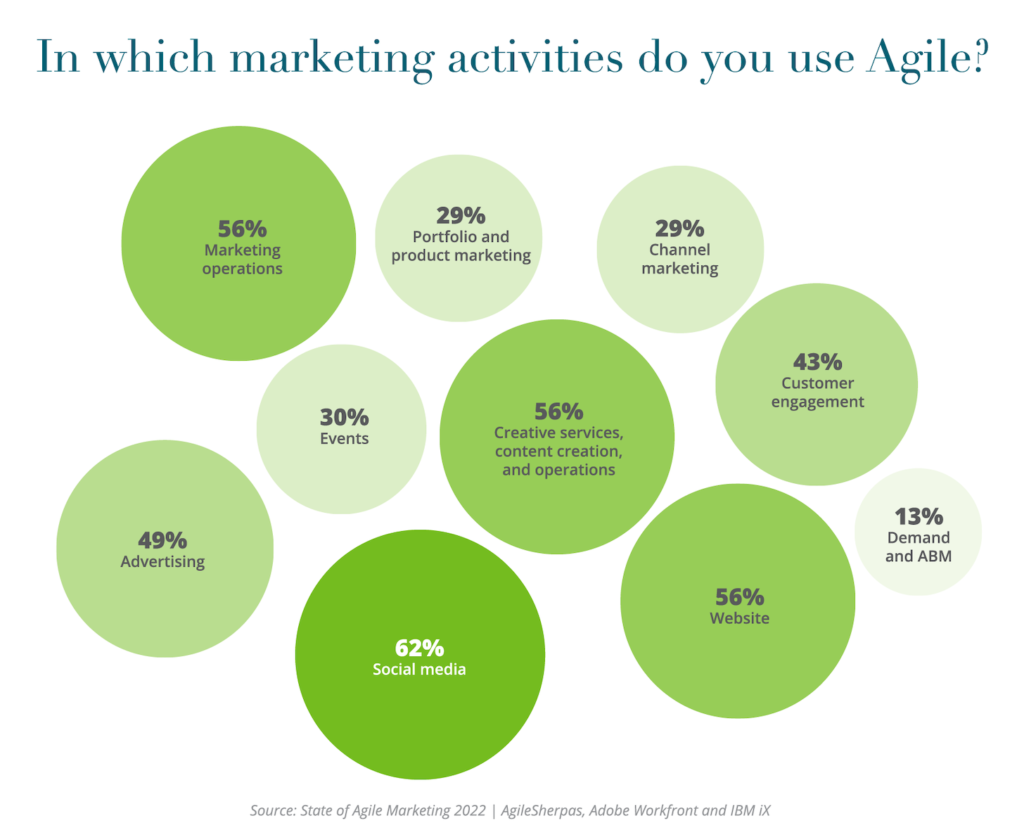Agile management was born 20 years ago, to help teams operate better in a fast-moving, ever-changing, digital world.
Agile originated in software development circles, with a bunch of programmers high in the mountains, and spread to other disciplines, eventually marketing. (“Hey, what are you all doing, standing around, chatting in a circle? With a whiteboard? Looks like fun! Can I join?”) Without even having to know what agile marketing actually meant, marketing teams knew it just sounded good.
In sheer volume of ink spilled on the subject, agile — or, capital-A Agile, if you’re going to be nit-picky about it — was extremely successful. For its time.
But times change.
Indeed, the world has changed. It’s gotten more fast-moving. And more ever-changing. And, with every device, appliance, and surface in our harried lives constantly nagging us, by beeping and buzzing, and buzzing and beeping, and BEEPING and BUZZING, and… um, where was I? Oh, yeah, it’s even more digital too.
We don’t just have automation.
We now have hyperautomation. (I swear, I’m not making that up.) We need a management methodology that can keep pace with this frenzied hell 21st-century Interwebbed nirvana.
And so, as one of the early champions of agile marketing, I’m thrilled to introduce you to the emerging practices of hyperagile marketing.
Agile marketing was based around the rituals and artifacts of Scrum.
Hyperagile marketing is based around Scram. Our rituals and artifacts are different. Better.
Instead of week-long or month-long (!) sprints, we have 24-hour hurtles. Picture that you’re being chased by a ravenous Jabberwock beast. That’s the motivated work environment that hyperagile Scram seeks to instill.
Since timelines are radically compressed in hyperagile marketing, we forgo the daily stand-up. They just take too long. Sure, the original idea of a “stand-up” was the assumption that people would exercise brevity in their updates if they were forced to stand for the whole meeting. But thanks to the evil of standing desks and trade show booths, people can talk while standing for-friggin’-ever.
So in Scram, we have the daily plank.
The whole team has to plank while everyone chimes in with their updates. We’re usually done in less than a minute. That’s hyperagile.
Instead of a product owner, there’s a dungeon master. Let’s face it, they’re good at making up stories and throwing nasty surprises at the poor band of characters who are forced to put up with it all for some meager experience to level up in their careers.
Instead of a Kanban board, we’ve thrown out that archaic artifact. Instead, we keep track of the status of all work-in-progress using a highly sophisticated neural net. When someone asks where things at, we just tap the side of our head and say, “Up here, in our hyperagile neural net.”
If they follow up with the question of, “Um, okay, when will it be done?” We’re able to give an instantaneous response: “Soon.” That’s state-of-the-art fuzzy logic at work for you.
Hey, it’s not our fault that neural nets are kinda black-boxy. Blame AI.
These interactions with other stakeholders are actually where the name “Scram” came from. We were in the middle of our first daily plank when that over-caffeinated fellow from sales ops came over to ask what we were doing. The team replied, “Scram.” History was made.
Backlogs are the bane of Scrum-based agile teams. They keep growing towards infinity, so that you’re constantly reminded of the gargantuan mountain of things that you’re not getting done. (A reporter recently asked the FBI if there were any updates on where Jimmy Hoffa was, and the spokesperson replied, “He’s in the backlog.”)
In theory, agile teams are supposed to prune the backlog. But that’s like pruning the Amazon. With a butter knife.
So with Scram, we’ve invented the brilliant mechanism of an auto-pruning backlog. As soon as someone adds something to the backlog, it’s automatically thrown out. Efficiency-squared.
If someone complains about that practice — “Hey, you just threw away my idea!” — you can reply in condescending tones that, “Hyperagile is a stream, not a pool.”
For the work the hyperagile team does hurtle its way through, there’s no Planning Poker. Instead, we have Planning Roulette. “Joe, you’ve got to get that whole campaign built and launched in — spins wheel — 90 minutes. Go!”
I’m barely scratching the surface of the amazing practices that Scram can bring to the modern, hyperagile marketing organization. So to further study and promote these sick management methods for the new-new-NEW normal, I’m proud to announce that today, April 1, 2021, I’m launching the Institute of Hyperagile Marketing (I-HAM).
We’ve founded I-HAM with a short and sweet Hyperagile Manifesto:
GET IT DONE. NOW, DAMN IT!
To commemorate the founding of the Institute, we’re making this article available for purchase as an NFT. The bidding starts at $4,012,021.





Happy April 1st! 🙂